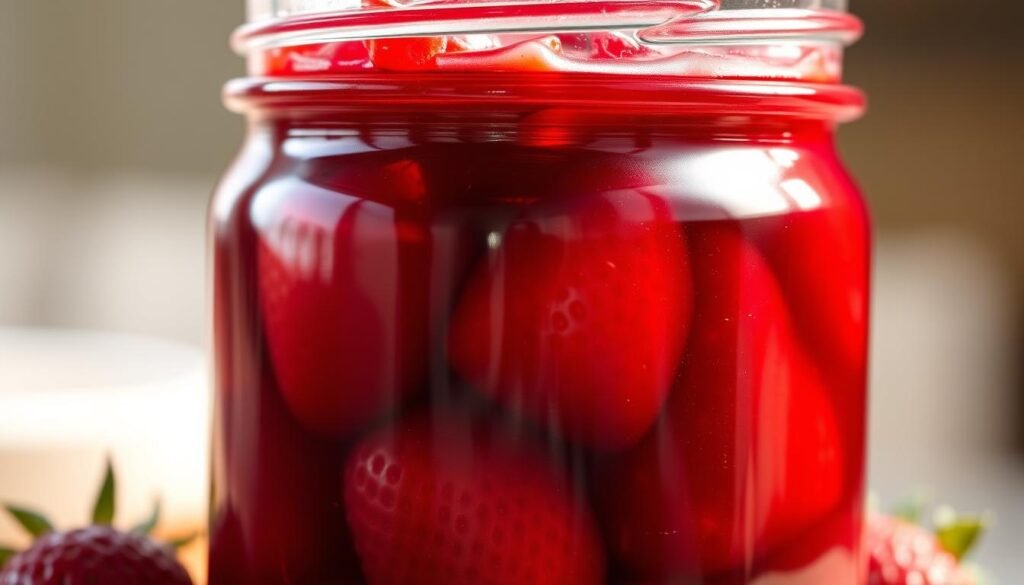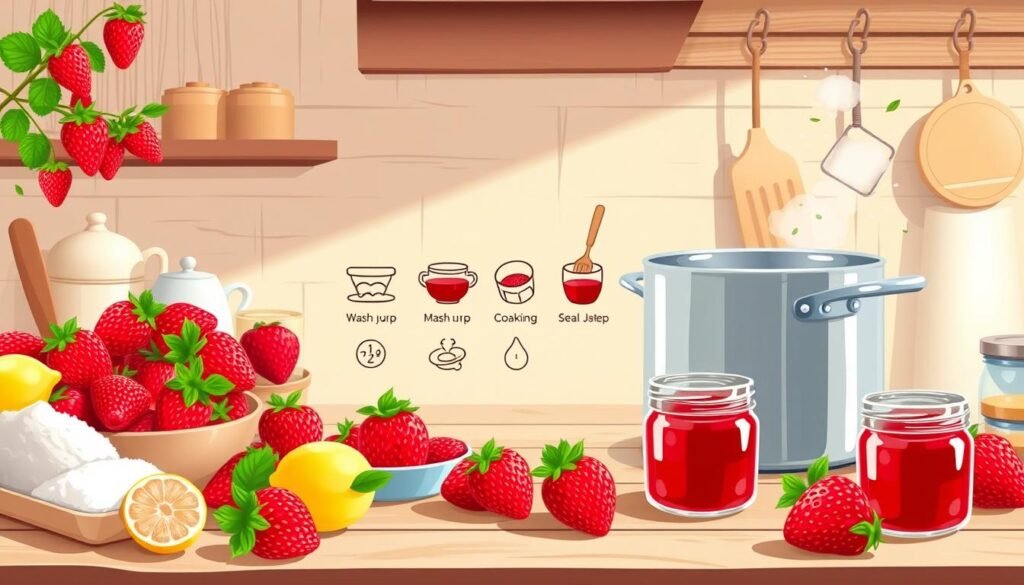What if your favorite breakfast spread could actually boost your health instead of derailing it? Many assume sweet fruit preserves are just sugary indulgences, but the truth might surprise you. Let’s dig into the real story behind this pantry staple.
Store-bought versions often pack hidden sugars, but homemade options flip the script. By swapping refined sweeteners for alternatives like honey or coconut sugar, you can create a vibrant, nutrient-rich topping. Fresh berries shine in these recipes, offering antioxidants and vitamins without artificial additives.
Not all jams are created equal. The key lies in ingredient choices and preparation methods. Even sugar-free versions burst with flavor when using ripe, seasonal fruit and clever substitutions. Want to enjoy toast or yogurt without guilt? The solution starts in your kitchen.
This guide breaks down the nutritional pros and cons of popular spreads. We’ll also share a simple recipe for crafting your own wholesome version later in the article. Ready to rethink your morning routine?
Key Takeaways
- Store-bought jams often contain excessive added sugars
- Homemade versions allow control over ingredients and sweetness levels
- Natural sweeteners like honey enhance flavor while reducing processed sugar content
- Fresh strawberries provide vitamin C and antioxidants
- Sugar-free recipes can still deliver rich taste and texture
- Upcoming sections include a step-by-step guide for healthier jam made at home
Healthy Strawberry Jam: Key Ingredients and Nutritional Essentials
Transforming ordinary toast into a nutrient-packed treat begins with smart ingredient choices. While commercial spreads often prioritize shelf life over quality, homemade recipes let you spotlight fresh flavors and wholesome components.

Powerhouse Nutrition in Every Jar
A single tablespoon of homemade preserves delivers 15% of your daily vitamin C needs, thanks to fresh berries and citrus. Unlike mass-produced versions containing 10+ grams of added sweeteners per serving, DIY blends use:
- Ripe red berries bursting with fiber
- Freshly squeezed lemon for natural thickening
- Unprocessed sweeteners like raw honey
Nature’s Thickening Secret
Pectin – found in apple skins and citrus peels – creates that perfect spreadable consistency without gums or additives. Combine this with organic produce, and you’ll notice brighter flavors compared to store-bought options. Check the difference:
| Homemade | Store-Bought | |
|---|---|---|
| Calories per tbsp | 25 | 50 |
| Added Sugars | 3g | 12g |
| Dietary Fiber | 1g | 0g |
Zest from organic lemons amplifies both taste and nutrient density. With these simple swaps, your morning toast becomes a vitamin-rich canvas rather than a sugar bomb.
Exploring is strawberry jam healthy: Benefits and Considerations
Your morning toast deserves more than just sweetness—it can be a nutritional powerhouse. Fresh fruit preserves pack antioxidants like ellagic acid, which studies link to cellular protection. A single tablespoon offers 10% of your daily vitamin C needs, supporting immune function and collagen production.

Nutritional Advantages in Every Spoonful
Homemade versions retain more natural fiber than commercial options, thanks to minimal processing. This soluble fiber aids digestion and helps stabilize blood sugar levels. For comparison, store-bought varieties often lose 40-60% of original nutrient content during high-heat preservation.
Crafting vs Buying: What’s Better?
Control over ingredients makes DIY recipes superior. While both types contain natural sugars, homemade blends avoid corn syrup and synthetic preservatives. See how they stack up:
| Feature | Homemade | Store-Bought |
|---|---|---|
| Antioxidants per serving | 85mg | 32mg |
| Added preservatives | 0 | 3-5 types |
| Pectin source | Citrus/Apple | Modified starch |
Natural pectin from citrus peels not only thickens spreads but also feeds beneficial gut bacteria. Shorter cooking times (under 20 minutes) help preserve heat-sensitive vitamins. For those monitoring sugar intake, low-sweetener recipes maintain flavor through ripe berries and spice additions like vanilla.
While sugar content remains a consideration, homemade versions let you adjust sweetness without sacrificing texture. The choice becomes clear when prioritizing both taste and wellness.
Recipe and Step-by-Step Guide for Homemade Healthy Strawberry Jam
Crafting a nutrient-rich spread starts with fresh, vibrant components. This approach lets you balance sweetness and nutrition while avoiding artificial additives. Let’s transform ruby-red berries into a luscious topping that elevates toast, oatmeal, or yogurt.

Gathering Quality Ingredients and Preparation Tips
Begin with 2 pounds of organic berries – their peak ripeness ensures natural sweetness. You’ll also need:
- ¼ cup lemon zest (from 2 medium citrus fruits)
- ⅓ cup coconut sugar for caramel-like depth
- 1 tbsp arrowroot starch for thickening
- 2 tbsp freshly squeezed citrus juices
Rinse fruit under cool water and pat dry. Remove green tops using a paring knife or huller. Slice larger pieces for even cooking.
Cooking Techniques: From Mashing to Thicken with Arrowroot Starch
Combine berries and citrus zest in a heavy pot. Crush gently with a potato masher to release juices while keeping some texture. Stir in coconut sugar and simmer over medium-low heat for 15 minutes, skimming foam.
Mix arrowroot with cold water to create a slurry. Gradually pour into bubbling fruit mixture, stirring constantly. The preserve will thicken within 3-4 minutes. Remove from heat when it coats the back of a spoon.
Pro Tip: For smoother consistency, blend half the cooked berries before adding thickener. Store in sterilized glass jars for up to 3 weeks refrigerated.
Conclusion
Redefining your favorite spread starts with simple choices. Homemade versions let you swap processed sugar for natural sweetness while keeping fiber and antioxidants intact. Unlike store-bought jams, DIY recipes use fresh fruit and clever thickeners like citrus pectin for better taste and texture.
Our step-by-step guide shows how a potato masher and quality berries create vibrant preserves in minutes. Storing them in airtight containers preserves freshness without artificial additives. For those watching sugar intake, low-sweetener options still deliver rich flavor through ripe fruit and spices.
Share your kitchen wins by pinning or printing the recipe. Small tweaks in ingredients make a big difference – swap corn syrup for honey or try coconut sugar for caramel notes. Explore more tips on crafting balanced spreads in our nutrition-focused guide.
Ready to upgrade your pantry? Whip up a batch this weekend and tag us with your creations. Wholesome food choices never tasted this good.




